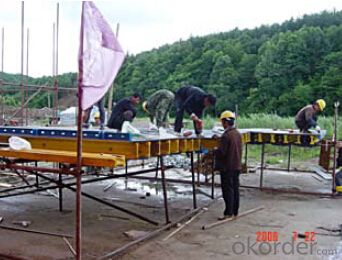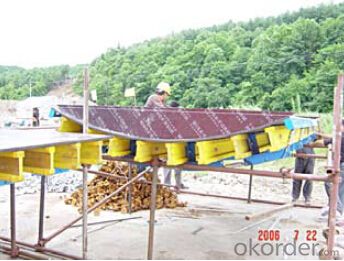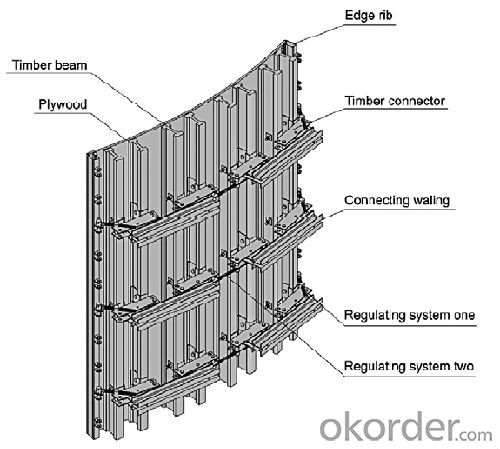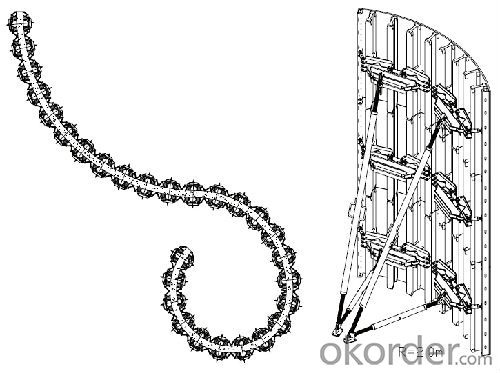Adjustable Arced Timber Beam Formwork for Circle Column
- Loading Port:
- Tianjin
- Payment Terms:
- TT or LC
- Min Order Qty:
- 50 m²
- Supply Capability:
- 1000 m²/month
OKorder Service Pledge
OKorder Financial Service
You Might Also Like
1. Structure of Curve Concrete Wall Formwork
TBW system-C is a kind of formwork for pouring curve wall, it is composed of several pieces of Tim-formwork, tie rod, wing nut, etc.
It will be designed according to wall’s size.
2. Main Features of Curve Concrete Wall Formwork
1. Quickly construction with TBW system-C.
2. Light weight but high bearing capacity. For conventional design, its load bearing capacity is 60KN/m2 with weight of 60-80kg/m2. If required, the formwork can be specially designed for higher concrete pressures.
3. Timber is easy re-sized, so the Tim-formwork is relatively easier to change self’s size and shape. This approved formwork’s economical efficiency.
3. Curve Concrete Wall Formwork Images


4. Curve Concrete Wall Formwork Specification


5. FAQ of Curve Concrete Wall Formwork
1) What can we do for you?
We can ensure the quality of the Curve Concrete Wall Formwork and avoid extra expenses for customers.
We can provide you the professional design team.
We can provide fashionable and newest styles for you.
We can design the artwork for you.
Please feel free to customize.
2) What promises can be done by us?
If interested in Curve Concrete Wall Formwork, please feel free to write us for any QUOTE.
If printing required, please advise asap because the whole set need much more time to complete.
Please DO check goods when courier knocks your door and contact us asap if any issue.
3) What about of our after-sale service?
Response will be carried out in 24hours after receiving any complain or request.
If the products are not based on the requirements, there will be the relevant compensations made for you.
4) What about the package and shipping time?
Packing: As Customer's Requirements
Shipping: We have various shipping ways for our customers, such as express which including TNT, DHL, FEDEX, UPS, EMS, etc. ; by air/ sea, and we are VIP of these express.
Shipping time:Normally small orders, it just 10-15 business days to arrive your hand; When comes to the customs declaration, it may need 7 days. Other mass qty of Curve Concrete Wall Formwork, we send them out by sea or by air to sea port or air port to save some shipping freight for our customers. By ocean, it may need 45~60days, by air, it may need 25~40days.
- Q:What are the considerations when designing steel formwork for dams?
- When designing steel formwork for dams, several key considerations need to be taken into account. Firstly, the structural stability and strength of the formwork is of utmost importance. Dams are large structures that exert significant forces, so the formwork needs to be able to withstand these forces without any deformation or failure. This requires careful analysis and design of the formwork system, including the selection of appropriate steel grades, sizes, and reinforcement. Another important consideration is the water pressure that the formwork will be subjected to during the construction and operation of the dam. The formwork needs to be watertight to prevent any leakage or seepage, as this can compromise the stability and integrity of the dam. Special attention should be given to the joints and connections of the formwork to ensure a tight and secure seal. Durability is another factor that needs to be considered when designing steel formwork for dams. Dams have a long design life, often spanning several decades, so the formwork needs to be able to withstand prolonged exposure to various environmental conditions, such as temperature changes, moisture, and chemical exposure. The formwork should be protected against corrosion, either through the use of corrosion-resistant steel or by applying protective coatings. The ease of assembly and disassembly is also an important consideration. Dams are complex structures that require a large number of formwork elements to be assembled and aligned accurately. The formwork system should be designed in a way that allows for easy and efficient installation and removal, minimizing the time and effort required for construction. Lastly, cost considerations play a significant role in the design of steel formwork for dams. The formwork system needs to be cost-effective and efficient, maximizing the use of materials and minimizing waste. The design should also take into account the availability and cost of steel, as well as the availability of skilled labor for fabrication and installation. Overall, the considerations when designing steel formwork for dams include structural stability, watertightness, durability, ease of assembly, and cost-effectiveness. By carefully addressing these factors, engineers can ensure the successful construction and long-term performance of the dam.
- Q:Can steel formwork be used for hotel construction projects?
- Yes, steel formwork can be used for hotel construction projects. Steel formwork is commonly used in construction due to its durability, strength, and versatility. It provides a sturdy and reliable framework for pouring concrete and can be easily assembled and dismantled, making it suitable for various construction projects, including hotel buildings.
- Q:Can steel formwork be used for foundation walls?
- Yes, steel formwork can be used for foundation walls. Steel formwork is a durable and strong material that provides excellent support for concrete during the construction process. It can be used for both horizontal and vertical applications, including foundation walls. Steel formwork offers several advantages such as high load-bearing capacity, reusable nature, and ease of installation and removal. It allows for precise shaping of foundation walls and ensures a smooth and uniform finish. Additionally, steel formwork is resistant to moisture and can withstand harsh weather conditions, making it suitable for foundation walls in various environments.
- Q:How does steel formwork affect the overall sustainability of a construction project?
- Steel formwork can have a significant impact on the overall sustainability of a construction project. Firstly, steel formwork is highly durable and reusable, which reduces the need for constant replacement and minimizes waste generation. This not only reduces the project's environmental footprint but also helps in cost reduction. Moreover, steel formwork provides a high level of accuracy and precision, resulting in efficient and streamlined construction processes. This leads to reduced material wastage and energy consumption, contributing to the sustainable use of resources. Additionally, the use of steel formwork enables faster construction cycles, which can reduce the project's overall energy consumption and greenhouse gas emissions. Steel formwork also offers versatility in design, allowing for complex and innovative architectural structures. This versatility can enhance the aesthetic appeal of a building, promoting its long-term use and reducing the likelihood of demolitions due to outdated designs. By extending the lifespan of a structure, steel formwork contributes to the sustainability of the project by reducing the need for additional construction and material usage. Furthermore, steel formwork can contribute to the overall structural integrity and safety of a building. Its strength and rigidity ensure stability during construction and throughout the lifespan of the structure. This reduces the likelihood of structural failures and the need for repairs or reconstruction, thereby minimizing waste generation and resource depletion. In summary, steel formwork positively impacts the overall sustainability of a construction project through its durability, reusability, precision, efficiency, versatility, and structural integrity. By reducing waste generation, energy consumption, and greenhouse gas emissions, steel formwork promotes the sustainable use of resources and contributes to the long-term viability of buildings.
- Q:What are the common maintenance practices for steel formwork?
- Some common maintenance practices for steel formwork include regular cleaning and removing any debris or concrete buildup, inspecting for any signs of damage or wear, repairing or replacing any damaged components, applying rust-resistant coatings or paint to prevent corrosion, and properly storing the formwork when not in use.
- Q:How does steel formwork handle different concrete reinforcement types?
- Steel formwork is an excellent choice for dealing with various types of concrete reinforcement due to its versatility and durability. It is commonly used in construction projects to create temporary molds or structures that hold concrete in place during the pouring and curing process. One of the benefits of steel formwork is its ability to handle different types of concrete reinforcement. Whether it's traditional reinforcement like steel bars or modern techniques such as fiber-reinforced polymers (FRP), steel formwork can accommodate them all. Steel formwork is specifically designed to be strong and rigid, enabling it to support the weight and pressure exerted by different reinforcement materials. It can withstand the forces exerted by steel bars or the tensile strength of FRP without experiencing any deformations or collapsing. Furthermore, steel formwork is highly adaptable and can be easily adjusted or modified to suit different reinforcement types. It can be cut or welded to create openings or recesses for steel bars or other materials to pass through. This flexibility guarantees that steel formwork can be tailored to meet the specific requirements of each construction project. Moreover, steel formwork provides a smooth and even surface finish, which is crucial for ensuring proper adhesion between the concrete and the reinforcement materials. This ensures that the reinforcement is securely embedded within the concrete structure, offering the necessary structural integrity and strength. To conclude, steel formwork is a dependable and efficient solution for managing different types of concrete reinforcement. Its strength, adaptability, and ability to provide a smooth surface finish make it an ideal choice for construction projects that necessitate diverse reinforcement materials.
- Q:How does steel formwork contribute to the overall speed of construction?
- Steel formwork contributes to the overall speed of construction in several ways. First and foremost, steel formwork is known for its high strength and durability, allowing it to withstand the pressure and weight of wet concrete. This means that construction teams can pour concrete into the formwork and proceed with the next steps of the construction process without having to wait for the concrete to fully cure or harden. As a result, this significantly reduces the overall construction time. Additionally, steel formwork is highly reusable, which further enhances the speed of construction. Unlike traditional timber formwork, which needs to be replaced after a few uses, steel formwork can be used multiple times without compromising its structural integrity. This eliminates the need for constant formwork preparation and allows construction crews to quickly move from one section to another, saving both time and resources. Moreover, steel formwork offers better precision and accuracy compared to other types of formwork. Its rigid structure ensures that the concrete is poured and shaped exactly as intended, minimizing the need for costly and time-consuming adjustments or corrections. This precision also enables construction teams to proceed with subsequent tasks, such as installing reinforcements or starting interior works, without delay. Furthermore, steel formwork is lightweight and easy to handle, making it quicker to assemble and dismantle. This ease of use allows construction crews to swiftly set up the formwork system, reducing the time spent on formwork installation. Similarly, when the concrete has sufficiently cured, the steel formwork can be easily disassembled and moved to the next construction site, further enhancing the speed of construction. In conclusion, steel formwork contributes to the overall speed of construction through its strength, durability, and reusability. Its precision and ease of handling also play a significant role in accelerating the construction process. With these advantages, steel formwork enables construction teams to complete projects more efficiently, saving time, and ultimately reducing costs.
- Q:How does steel formwork contribute to the overall sustainability of a structure?
- Steel formwork contributes to the overall sustainability of a structure in several ways. Firstly, steel formwork is durable and reusable, which minimizes waste and reduces the need for new materials in subsequent construction projects. This not only reduces the environmental impact but also saves costs in the long run. Additionally, steel formwork allows for efficient and precise construction, which reduces the overall construction time and energy consumption. Lastly, steel formwork can withstand harsh weather conditions and has a longer lifespan, ensuring the longevity and resilience of the structure, thus reducing the need for frequent repairs or replacements.
- Q:How does steel formwork affect the overall construction site organization?
- Steel formwork can have a significant impact on the overall organization of a construction site. Firstly, steel formwork is known for its durability and reusability, which means it can be used multiple times for different projects. This allows for better planning and scheduling of construction activities, as the availability of formwork is more predictable and reliable. Additionally, steel formwork is known for its precision and accuracy, which leads to better quality construction. This can result in fewer reworks and delays, as the formwork ensures that concrete is poured in the right place and to the correct dimensions. Consequently, the overall construction process becomes more efficient, allowing for better organization and coordination of various trades and activities on the site. Steel formwork also offers flexibility in design and construction. It can be easily adjusted and modified to accommodate changes in the project, such as alterations in the shape or size of concrete elements. This adaptability reduces the need for additional materials and resources, which can streamline the organization of the construction site and minimize waste. Furthermore, steel formwork is known for its strength and stability. This allows for taller and larger concrete structures to be constructed, which can have implications for the overall layout and organization of the site. For example, it may require additional crane or lifting equipment to handle the heavier and larger formwork components. This necessitates careful planning and coordination to ensure that the site is properly organized to accommodate these requirements. In summary, steel formwork positively impacts the overall organization of a construction site by providing durability, precision, flexibility, and strength. These attributes contribute to better planning, scheduling, and coordination of construction activities, resulting in improved efficiency, quality, and adaptability.
- Q:Can steel formwork be used in bridge construction projects?
- In bridge construction projects, steel formwork can be utilized. Steel formwork is a temporary structure employed to support and shape the concrete throughout the construction phase. It is extensively applied in diverse construction projects, including bridges. By employing steel formwork, several advantages are obtained in bridge construction, such as enhanced strength, durability, and resistance to deformation. The structure can withstand the weight of the concrete and other construction materials, thereby guaranteeing the stability and integrity of the bridge. Moreover, steel formwork offers flexibility in creating intricate bridge designs, enabling the construction of various bridge types, such as arch bridges, cable-stayed bridges, and suspension bridges. The integration of steel formwork in bridge construction projects aids in simplifying the construction process, enhancing efficiency, and ensuring the quality of the final bridge structure.
1. Manufacturer Overview |
|
|---|---|
| Location | |
| Year Established | |
| Annual Output Value | |
| Main Markets | |
| Company Certifications | |
2. Manufacturer Certificates |
|
|---|---|
| a) Certification Name | |
| Range | |
| Reference | |
| Validity Period | |
3. Manufacturer Capability |
|
|---|---|
| a)Trade Capacity | |
| Nearest Port | |
| Export Percentage | |
| No.of Employees in Trade Department | |
| Language Spoken: | |
| b)Factory Information | |
| Factory Size: | |
| No. of Production Lines | |
| Contract Manufacturing | |
| Product Price Range | |
Send your message to us
Adjustable Arced Timber Beam Formwork for Circle Column
- Loading Port:
- Tianjin
- Payment Terms:
- TT or LC
- Min Order Qty:
- 50 m²
- Supply Capability:
- 1000 m²/month
OKorder Service Pledge
OKorder Financial Service
Similar products
New products
Hot products
Related keywords






















